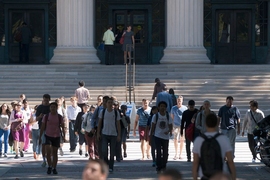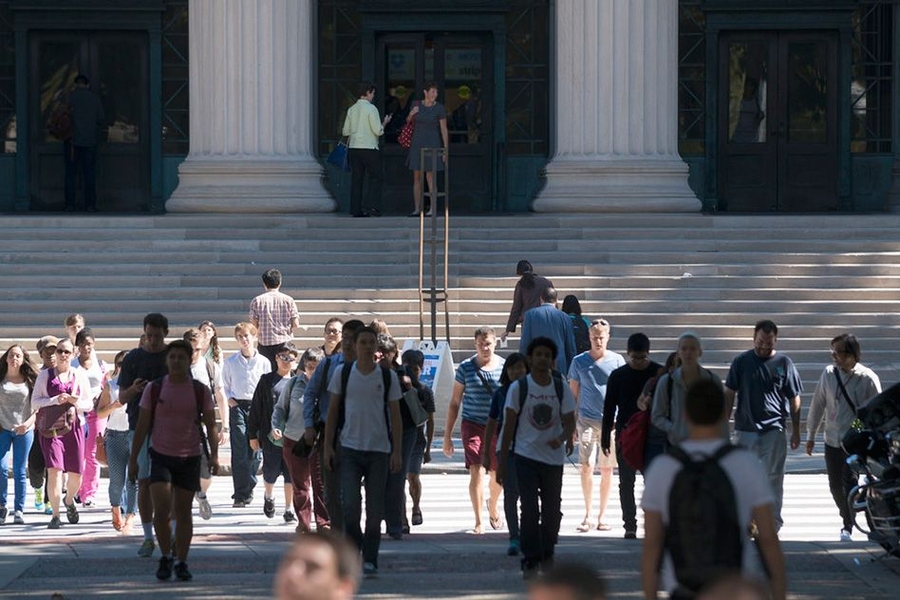MIT will substantially increase its financial aid expenditures for the coming year, taking steps that will benefit students and families across the economic spectrum.
The changes — which will result in more generous MIT scholarships for nearly all students who receive financial aid — will drive a 10.4 percent increase in the Institute’s undergraduate financial aid budget for 2016-17, to $114.2 million.
The 10.4 percent increase in the financial aid budget — which offsets an increase of 3.7 percent in undergraduate tuition, fees, and housing and dining expenses — was announced today at a meeting of the MIT Corporation.
“Next year’s financial aid budget advances MIT’s longstanding commitment to access and affordability,” says Chancellor Cynthia Barnhart. “This decision ensures that students and families will have more help managing their education costs.”
As part of the increase in its financial aid budget for 2016-17, MIT will reduce the expected contribution that parents make toward their students’ expenses across the board. As such, these financial aid enhancements will benefit all students who receive financial aid but whose parental contribution is now more than $0. The Institute will also remove consideration of home equity as a factor in awarding financial aid; home equity had previously been considered for families earning more than $150,000 annually.
With these changes, the average MIT scholarship, for students receiving financial aid, will rise to an estimated $44,591. One-third of MIT undergraduates receive aid sufficient to allow them to attend the Institute tuition-free; the new financial aid budget is expected to increase the number of students who fall into this category.
For undergraduates who do not receive need-based financial aid, tuition and fees will be $48,452 next year. With average housing and dining costs included, students not receiving financial aid will pay $62,662 next year.
The Institute’s $114.2 million budget for undergraduate financial aid next year is a dramatic increase from the $30.5 million allocated in 2000 — a sustained rate of growth that far exceeds tuition and fee increases during the same period.
“This is an important step forward in our ongoing work to make MIT a more welcoming and inclusive place for every member of our community,” says Rasheed Auguste, a junior majoring in nuclear science and engineering and co-chair of the Black Students’ Union (BSU) who, along with other members of the BSU, recommended last December that senior administrators reaffirm MIT’s commitment to accessibility and affordability by increasing financial aid. “By increasing MIT’s affordability, we will reduce financial stresses on students and families — and underrepresented minorities in particular — making it easier for students to focus on why they are here: to get a strong, balanced education and build a foundation for high achievement and innovation.”
MIT is one of only five American colleges and universities that currently admit all undergraduate students without regard to their financial circumstances, award all financial aid based on need, and meet the full demonstrated financial need of all admitted students.
For students with family incomes under $80,000 a year and typical assets, MIT guarantees that scholarship funding from all sources allows them to attend the Institute tuition-free. While the Institute’s financial aid program primarily supports students from lower- and middle-income families, even families earning more than $200,000 may qualify for need-based financial aid based on their family circumstances, such as if two or more children are in college at the same time.
About 60 percent of MIT’s 4,527 undergraduates receive need-based financial aid from the Institute, including 33 percent who attend MIT tuition-free and 18 percent who receive Federal Pell Grants, which generally go to students with family incomes below $60,000.
Students receiving need-based financial aid from MIT, as well as Pell Grants, continue to benefit from MIT’s Pell Grant Matching Program, which helps such students to graduate with little or no debt. That program was created in 2006 to allow MIT students to use their Pell Grants to defray what they are expected to contribute to their education through work and loans.
Last year, 68 percent of MIT seniors graduated with no debt; of those who did assume debt to finance their education, the median indebtedness at graduation was $18,859.







